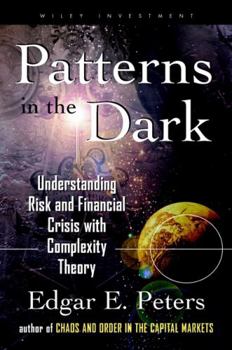Complexity, Risk, and Financial Markets
Select Format
Select Condition 
Book Overview
Die Komplexit?tstheorie besagt, da Prozesse mit einer gro en Anzahl scheinbar unabh?ngiger Faktoren, wie z.B. freie M?rkte, sich spontan zu einem koh?renten System zusammenschlie en k?nnen. Auf der Grundlage wissenschaftstheoretischer und wirtschaftswissenschaftlicher Aspekte demonstriert der Autor, wie sich das Zufallsprinzip und die Ungewi heit der Komplexit?tstheorie auf die Finanzm?rkte anwenden lassen. Verst?ndlich und spannend geschrieben,...
Format:Hardcover
Language:English
ISBN:047123947X
ISBN13:9780471239475
Release Date:April 1999
Publisher:Wiley
Length:240 Pages
Weight:1.15 lbs.
Dimensions:1.0" x 6.4" x 9.3"
Customer Reviews
3 ratings
i loved this chaos theory intoduction
Published by Thriftbooks.com User , 17 years ago
I'm not a math gueek, evolutionist, or statistician. What I wanted was someone to expalain, in as simple terms as possible, what "complexity" is in terms of systems analysis - be that social, economic or otherwise. Kudos to Peters for delivering just that. I read the negative reviews written before my own, considered them, and then I bought the book anyway. Frankly, I'm glad Peters "dumbed down" this topic for me. That's what I wanted. Not knowing much about the subject, I was still able to sense where some errors of omission were being made. And there are a few. I wish he would have finished his thought on the Monte Hall problem, for example. Don't buy this book if you are thinking it's full of exciting mathematical equations or advanced theory. It isn't. It's just an introduction to complex/chaotic systems written for the average Joe/Jane. For all the flap over "missing Keynes' contribution" or "misrepresenting Darwin," he may very well do that. I did not buy this book expecting Peters to be a Keynes scholar or a Darwinian evolutionist. If he has read 0 Keynes and 0 Darwin, I think we can still consider him an expert on complex and chaotic systems. Certainly, Keynes and Darwin were not. I expected that Peters might know a little bit about chaos theory and complexity as it relates to the realm of economics. And that he does. So, again, kudos to Mr. Peters for dumbing down this complex topic (pun intended) enough to create a starting point for me.
Peters has overlooked Keynes's contributions in this area
Published by Thriftbooks.com User , 19 years ago
Peters does an excellent job in clearly differenciating between the concepts of complexity, ignorance,risk,uncertainty,vagueness,and ambiguity.He shows how each concept has an important separate ,yet interrelated ,clearcut role to play in financial decision making.Unfortunately,Peters overlooks the fact that John Maynard Keynes had already provided an operational approach for such a decision making approach in his A Treatise on Probability(TP)in 1921.The role of conflicting and ambiguous evidence in decision making in general was discussed by Keynes in his rain-barometer-dark clouds example in chapter 3 of the TP.Keynes's point in discussing this particular problem was to show that it would be difficult to measure and quantify this particular dimension of a decision problem.The implicit danger is that no account will be taken of it if a strictly quantitative approach to decision making is taken.The importance of vagueness was discussed by Keynes in chapter 1,p.5,chapter 2,p.17 and in chapter 22,p.259.Complexity is discussed within the context of Keynes's discussion of induction and analogy.The ability to reason inductively starts to break down if the number of important independent factors(Keynes's principle of limited(finite)independent variety)grows too large and/or the interactive effects start to exhibit nonlinear relationships instead of proportionate,linear relationships.The clearcut differences between ignorance,uncertainty and risk in general decision making were discussed in chapters 6(the introduction)and chapter 26(the conclusion).Keynes defined an index to measure what he called the weight of the evidence,w, upon which probability estimates would be based.w is a measure of the completeness and the reliability of the relevant,potential,available evidence and information that a decision maker can obtain( or be aware of its existence).w is defined on the unit interval [0,1],where 0<=w<=1.Keynes's discussion of the Ellsberg Paradox takes place in chapter 6 of the TP forty years before Ellsberg published his 1961 paper.Keynes's w is practically the same as Ellsberg's rho measure of ambiguity.In the General Theory,Keynes defines uncertainty to be an inverse function of the weight of the evidence,where u(uncertainty)is a function of w.Thus,u=f(w).Ignorance(w=0),uncertainty(0<w<1)and risk(w=1)are all defined by Keynes relative to his w index.Risk can then be either linear(proportionate) or nonlinear(nonproportional).Keynes wraps all of this up into his conventional coefficient of weight and risk,c. c is a decision rule that incorporates nonlinearities in decision making.The goal of the decision maker is to maximize cA,where A is some outcome and c equals (p/1+q)(2w/1+w).This rule generalizes the expected value rule and the expected utility rule.Keynes doesn't make the common error of conflating risk with diminishing marginal utility.Finally,Keynes is the founder of the interval estimate approach to probability.Each probability has an upper
Peters sheds light on complexity theory in finance!
Published by Thriftbooks.com User , 24 years ago
Ever the standard bearer for the rational approach in the complacent and often hide-bound practices of most people to the world of financial-economics, Peters makes a compelling and ultimately convincing case for the paradigm of complexity to supplant that of equilibrium. Lest the rank-and-file practitioner forget, the most humble methods one has for interpreting any information in the market have their conceptual grounding from the 1930's application of equilibrium in physics to economics. These humble methods include the Portfolio Theory of the 1970s and Graham & Dodd of the 1930s. What most practitioners fail to appreciate is that once that conceptual foundation is changed from equilibrium to complexity, every metric and every conclusion drawn from those metrics change also. The changes Peters highlights, while based on solid science, challenge much of the convetional wisdom. It is the millenium and age of enlightenment. Investors should treat themselves to some of the same and read this book. Christopher MAY - author Nonlinear Pricing





